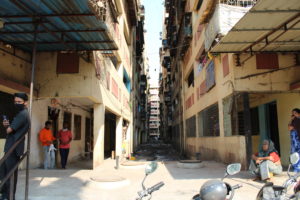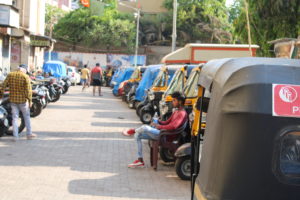Slum Rehabilitation Projects in Mumbai

Around 40,000 people are cramped inside 61 buildings at the Natwar Parekh SRA Colony in Govandi, north-east Mumbai (MIG photos/ Varsha Singh)
Over the past three decades Mumbai has seen numerous Slum Rehabilitation Projects. Most of them are badly designed and terribly executed, making them a fertile ground for various diseases. A full blown outbreak of covid-19 would be catastrophic in these areas.
Media reports over the past week have highlighted the spread of covid-19 in Asia’s largest slum, Dharavi, where three persons are believed to have succumbed to the pandemic. However, barely 10 km away from Dharavi is a large slum rehabilitation project Natwar Parekh SRA Colony in Govandi, north-east Mumbai, where the deaths of two persons have largely gone unnoticed.
Residents of the colony say that over the past three days, two persons died and both were found to be covid-19 victims. The number of deaths may be small for now, but Natwar Parekh and hundreds of other SRA projects, littered all over Mumbai, offer just the kind of environment where the coronavirus flourishes.
Soon after their death, medical professionals tested the family members of both the deceased. One of the deceased person’s family tested negative while all the five members of the other family tested positive. All the residents of the same building were subsequently tested and the entire building was sanitised.
A large complex of 61 buildings, the SRA is home to over 20,000 persons, most of who had been living in various slums all over Mumbai. The buildings are seven floors each and house 96 families each and crowded together. However, as in most public housing projects, the construction here is pathetic and the design not at all user friendly, with poor ventilation and no community spaces. As a result, the entire complex resembles a multi-storey slum, with garbage littered all around the buildings.
Stepping into one such building, which serves as home to Sharada and 21 other members of her extended family, a visitor encounters dark alleys, narrow staircases and even smaller corridors. Each unit is barely 225 sqft (22 sqm) where an average family of at least 5-6 persons live.
“I sell fish for a living. With a family of 22 it has always been difficult to survive with the little income that we were making. However, now with the lockdown, neither do we have any money nor do we have the luxury to practice social distancing in this cramped space,” Sharada tells Media India Group.
No help for the daily wagers
Sharada’s story is practically true for everyone living in the colony. “Most of the people living here are daily wagers. With the lockdown there is complete uncertainty on how everyone living here would be able to feed their families for so long? So far, we have not received any assistance from the government or our elected representatives, leaving us to fend for ourselves,” Parveen Shaikh, president of the resident’s association tells Media India Group.
She adds that so far the association has been trying to help the residents with the support of some NGOs and individuals, who have donated food supplies and other essential items. However, Shaikh says it’s not enough. “The supplies that we get will hardly help 200 families for a week. What about the 20,000 people living here? How will they manage for 21 days?” she asks.
Health hazard
Food is not the only thing that the government should be taking care of. An equally important issue for the residents is their health. With people living so close together, there was hardly any visit from health authorities to check on the residents. It was only after the first death that the authorities woke up. However, their action was limited only to one building and there haven’t been any checks in the 59 other buildings.
As almost all residents in the complex lead hand to mouth existence, getting themselves tested at a private facility is beyond their reach and the few public testing centres are too crowded. Even if some residents are ill, they don’t get themselves tested, increasing the chance of spreading the disease. “There are many people living here who have regular flu. However, how are we going to be sure that it’s not covid?” adds Shaikh.
“The municipal authorities have made a couple visits to our colony and said that they will come for regular checkups. Till now they are saying they will conduct check-up for all, but we don’t know when,” says Shaikh.
A hub for diseases
Coronavirus is not the only disease threatening the health of the residents of Natwar Parikh colony and other SRA projects. Five years ago, a study conducted by an NGO of doctors found that many SRA projects in the city had become hotbeds of tuberculosis.
“The high density, and lack of adequate light and ventilation in the apartments of Natwar Parekh Compound has led to a high risk of Tuberculosis. On an average, 1 in 10 families have someone with suffering with TB in Natwar Parekh Compound. The Development Control Regulations have to be looked at critically to ensure that Slum Rehabilitation Buildings are under the same considerations as general buildings in Mumbai,” Sandhya Naidu Janardhan, managing director of Curry Stone Design Collaborative, an architecture firm that also engages in working with marginalised communities to address inequities in the built environment, tells Media India Group.
Naidu says that the SRA scheme has not addressed key challenges such as density of population, leading to creation of a zone highly sensitive to infectious diseases. “The average population density in Mumbai is 206 persons per hectare, but the density is much higher in SRA projects as the developers are expected to pack in the maximum number of buildings in a small area as per city government requirements. At Natwar Parikh compound, for instance, the population density is 4,880 persons per hectare, almost 10 times the limit recommended by the building norms prevalent in Mumbai,’’ she says.
Little wonder then that various infectious disease spread rapidly amongst the people in SRA homes. And if indeed covid-19 becomes a full blown epidemic in an SRA complex, it is bound to lead to a large number of casualties. Once the covid crisis is over, the municipal authorities should ensure that proper space and place be provided for future projects.










